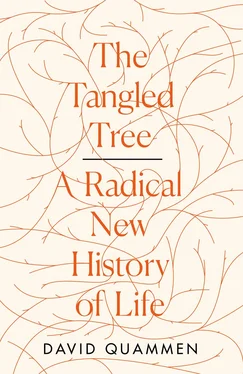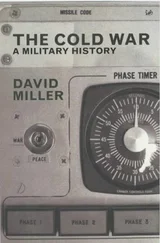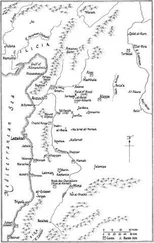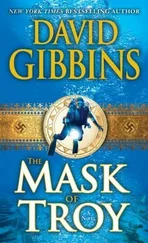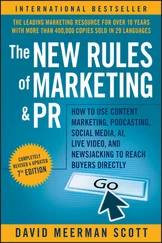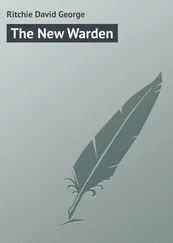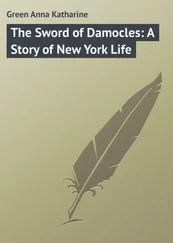“ My work had sort of come to a climax,” he said later, and he didn’t care to morph into an administrator. He declined a knighthood, having no desire to be addressed as “Sir Fred” by friends and strangers. “ A knighthood makes you different, doesn’t it,” he said, “and I don’t want to be different.” But that Cincinnatus retirement lay long in the future when Carl Woese, in his 1969 letter to Crick, daydreamed of getting a Sanger protégé to help him.
One of Sanger’s grad students had already come to Urbana, in fact, as a postdoc in the lab of another scientist within Woese’s department. That postdoc was David Bishop, brought over to assist Sol Spiegelman in sequencing viral RNA. Spiegelman had recruited Woese to the University of Illinois, rescuing him from obscurity at General Electric, in 1964. One year after Bishop’s arrival, Spiegelman left Illinois, returning to Columbia University in New York City, where his career had begun, and eventually taking Bishop with him. That might have yanked the Sanger techniques beyond Woese’s grasp. But in the interim months, Woese found a promising doctoral student named Mitchell Sogin and assigned him to learn what he could from Bishop before Bishop left. Molecular biology was in its formative phase, and though results could be announced in journal papers, the gritty details of lab methodology were often passed person to person, like the gift of stone tools or fire.
Mitch Sogin was a bright Chicago kid who had come down to the University of Illinois as an undergraduate on a swimming scholarship, planning to do premed. The swimming ended, the allure of medicine faded, but Sogin stuck around to earn a master’s degree in industrial microbiology within the Department of Food Science, part of the College of Agriculture. He worked on bacteria—specifically, the germination of bacterial spores, a matter of some practical interest to the food industry, given the implications for human health. Carl Woese, inhabiting a different department, almost a different universe, happened to have a lingering interest in spore germination from studies earlier in his career. For that slim reason, someone sent young Sogin to meet him. They clicked.
“And so I would go down and talk to him,” Mitch Sogin told me, almost fifty years later. “I liked him.”
Sogin was seventy at the time of our conversation, with a face that looked youthful but was now framed by thick, white hair. Behind his glasses, with his diffident smile, he resembled a professorial Paul Simon. We sat in his third-floor office in an old redbrick building on Water Street in Woods Hole, Massachusetts, headquarters of the Marine Biological Laboratory, a venerable research institution, where Sogin held the position of senior scientist and director of a center for comparative molecular biology and evolution. He seemed slightly bemused to have ended up there at Woods Hole, studying microbial communities of the oceans, microbial communities of the human gut, and microbial stowaways on space vehicles bound for Mars, as I nudged him to recall his early encounters with Carl Woese, back in 1968.
At that dicey moment in history, Sogin found himself, by age and geography, at the top of the rolls for his local Selective Service board. He hadn’t been drafted yet, but it seemed imminent, and this was before the first lottery made draft boards less arbitrary. “I had to make a sudden decision whether to stay in school or whether to go to Vietnam.” The war was at its ugliest; the Tet offensive in February that year had curdled the thinking of many young American males (including Mitch Sogin and me), and, unfair as it was, you could still get a deferment for graduate school. “Decided to stay in school,” Sogin told me. “It was simple.” He began work toward a doctorate under the mentoring of Woese. His topic was ribosomal RNA.
Woese had noticed something about Mitch Sogin during their early interactions: the kid was not just smart but also handy around equipment. Some combination of talents—dexterity, mechanical aptitude, precision, patience, a bit of the plumber, a bit of the electrician—made him good not just at experimental work but also at creating the tools for such work. Sol Spiegelman had ordered and paid for a collection of apparatus to be used for RNA sequencing by the Sanger method; but now Spiegelman was off to Columbia, leaving behind the tools.
“So Carl inherited that equipment. But he had no one that knew how to use it.” No one, that is, until Sogin joined his lab. “I was essentially responsible for importing all the technology”—importing it from Spiegelman’s lab, and other sources, into the Woese operation. Sogin learned as much as possible from Bishop about Fred Sanger’s techniques before Bishop decamped to New York, and then Sogin became Woese’s handyman as well as his doctoral student, assembling and maintaining an array of hardware to enable the sequencing of ribosomal RNA.
Woese himself was not an experimentalist. He was a theorist, a thinker, like Francis Crick. “He never used any of the equipment in his own lab,” Sogin said. None of it—unless you count the light boxes for reading films. Sogin himself had built these fluorescent light boxes, on which the film images of RNA fragments, cast by radioactive phosphorus onto large X-ray negatives, could be examined. He had converted an entire wall of bookshelves, using translucent plastic sheeting and more fluorescent bulbs, into a single big, vertical light box, like a bulletin board. They called it the light board. Viewed over a box or taped up on the light board, every new film would show a pattern of dark ovals, like a herd of giant amoebae racing across a bright plain. This was the fingerprint of an RNA molecule. Recollections from his lab members at the time, as well as a few old photographs, portray Carl Woese gazing intently at those fingerprints, hour upon hour.
“ It was routine work, boring, but demandingfull concentration,” Woese himself recalled later. Each spot represented a small string of bases, usually at least three letters but no more than about twenty. Each film, each fingerprint, represented ribosomal RNA from a different creature. The sum of the patterns, taking form in Carl Woese’s brain, represented a new draft of the tree of life.
The mechanics of this effort in Woese’s lab, during Mitch Sogin’s time and for much of the next decade, were intricate, laborious, and a little spooky. They involved explosive liquids, high voltages, radioactive phosphorus, at least one form of pathogenic bacteria, and a loosely improvised set of safety procedures. Every boy’s dream. Courageous young grad students, postdocs, and technical assistants, under a driven leader, were pushing their science toward points where no one, not even Fred Sanger or Linus Pauling, had gone before. The US Occupational Safety and Health Administration (OSHA), though recently founded, was none the wiser.
The fundamental goal was to sequence variants of a molecule from the deepest core of all cellular life, compare those variants, and deduce the history of evolutionary relationships since the beginning. Woese had already settled on that one universal element of cellular anatomy, the ribosome, the machine that turns genetic information into proteins, but there remained a crucial decision: Which ribosomal molecule should he study? Ribosomes comprise two subunits, as I’ve mentioned—a small one snuggled beside a larger one, like an auricle and a ventricle of the heart, each constructed of both RNA and proteins. The RNA fractions include several distinct molecules of different lengths. At first, Woese targeted a short RNA molecule from the large subunit, known as 5S (“five-S”) for obscure reasons that I don’t ask you to contemplate. Just remember 5, a smallish number. That molecule proved unsatisfactory because its very shortness limited the amount of information it contained. The alphabet of nucleotides composing RNA is slightly different from that of DNA—it’s A, C, G, and U (for uracil) in place of T (for thymine)—and there was just not enough of the A-C-G-U alphabet in any little 5S sequence to distinguish different creatures from one another. So he switched to a longer molecule in the small subunit, and at the risk of causing your eyes to roll back in your head, I’m going to tell you its name. Why? Because it’s important, and once you’ve got it, you own it: 16S rRNA. There. Not so bad?
Читать дальше
